How to remove ms office from Mac? Is there a Mac office uninstaller tool? Today, Let me tell you how to uninstall Microsoft office on mac Catalina. As we all know, installing applications on our Mac computer is actually easy. However, trying to uninstall them may sound easy but actually, they are not.
Office 2016 is one of the useful applications that we use especially if you are using your Mac for business purposes and school projects. Since there are updated Microsoft Office that has been released then that is the time that we delete the old ones on our computer. Or when it occupies too much space to cause the application memory to run out of, we will also need to remove office from Mac.
Here, we have gathered some ways you can do to uninstall Microsoft Office 2016 Mac completely without leaving any other files behind so just keep on reading this article.
Contents: Part 1. Can I Uninstall Microsoft Office?Part 2. How to Uninstall Office 365 (2011/2016) on Mac ManuallyPart 3. What Is The Best Microsoft Office Removal Tool for Mac?
Part 1. Can I Uninstall Microsoft Office?
You may want to uninstall Microsoft Office on Mac due to some installing errors, like installing a higher edition of Microsoft Office for Mac but failed. In this case, you need to uninstall the older version first. Or there may be something wrong when you are using the Office application, which really has a big impact on your work.

Is It Safe to Uninstall Microsoft Office?
You may think if it is safe to uninstall Microsoft Office, what happens if uninstall Microsoft Office? Well, UITS (University Information Technology Services) strongly recommends that you uninstall other versions of Microsoft Office before installing any new one. Because other Microsoft applications sometimes may conflict with the Microsoft Office installation. So it's safe to remove the Office and it won't delete files you created before in this Office version.
Below are some options on how to uninstall Microsoft Office on Mac and then install a new Office on your Mac or just for free up space. Yes, it is true that you can remove apps on your Mac by moving the application to your trash but there are files remaining. So is there an office removal tool for Mac to help you uninstall the office and all the related files completely? Microsoft has offered this kind of tool for Windows but not for Mac.
Thus, PowerMyMac should be created to help you remove all the Office apps including Word, Excel, PowerPoint, OneNote, and Outlook, and all their related files together. Different versions all can be removed at one time. (Jump to Part 3 to learn more details)
Part 2. How to Uninstall Office 365 (2011/2016) on Mac Manually
So how to delete Microsoft Office from Mac? Most people would just drag the application to the trash bin and thought that it was the right way to remove an application on Mac but this is really wrong. Because there will be leaving a lot of files that are connected to the app that you just removed like the system cache, app preferences, saved states, and some other files.
If you want to know how to uninstall Microsoft office on Mac completely, then all you need to do is to follow the simple guides indicated below. However, for you to do this, you must be able to sign in as an administrator on your Mac and provide a name and a password. Let's learn how to uninstall and reinstall Microsoft Office on Mac below.
Remove Office 365 (2011) For Mac Applications
- Launch Finder and then select Applications
Commandand then click for you to be able to choose the folder of Microsoft Office 2011.- After that press the
Ctrlbutton and then click an application you select and then Move to Trash.
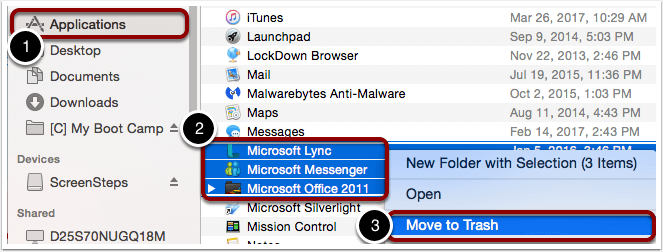
Remove Office 365 (2016) on Mac
1. Remove Office Application
- Launch Finder and then select Applications.
- Press
Commandand then click to choose all the related Microsoft Office 365 (2016) applications like Word, Excel, PowerPoint, and Outlook. - Press the
Ctrlbutton and click the apps you choose then Move to Trash.
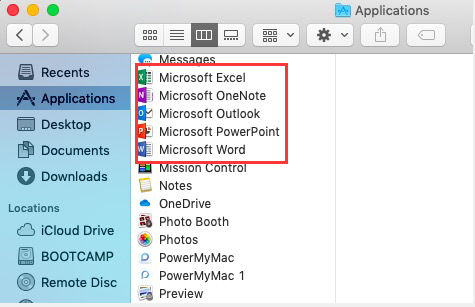
2. Remove All Related Files from Your User Library Folder
How to remove Office license files on a Mac? For you to be able to remove all of your files from your user library folder, what you need to do first is to set the Finder View options:
- Launch Finder and then press the "
Command + Shift + h" at the same time - Go to the Finder menu located at the top and then click on the "View" button and then click "as List". After that, click on the "View" button and then choose "Show View Options"
- Once you are in the View Options dialog box, choose "Show Library Folder" and then click on the Save button.
- Go back to your Finder and then launch Library and choose Containers. After that,
Ctrl +click all the folders and then choose Move To Trash.
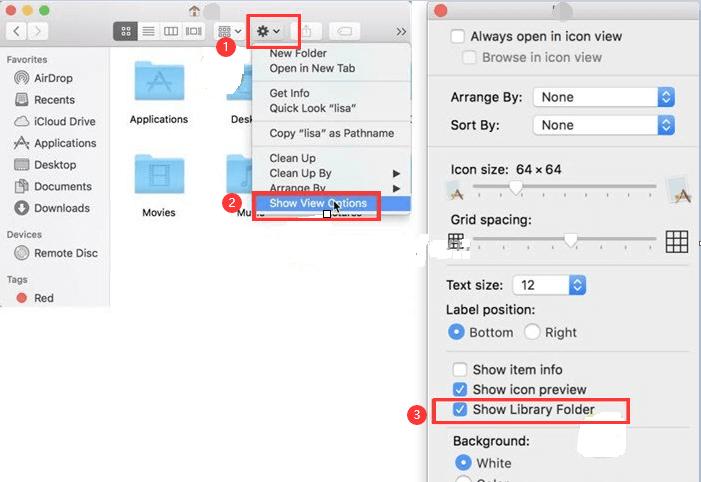
com.microsoft.errorreportingcom.microsoft.Excelcom.microsoft.netlib.shipassertprocesscom.microsoft.Office365ServiceV2com.microsoft.Outlookcom.microsoft.Powerpointcom.microsoft.RMS-XPCServicecom.microsoft.Wordcom.microsoft.onenote.mac
5. After that, click on the back arrow for you to go back to the previous page which is the Library folder. Once you are back on your Library folder, launch Group Containers. After that Ctrl + click each of the folders below if they are present and then Move To Trash.
UBF8T346G9.msUBF8T346G9.OfficeUBF8T346G9.OfficeOsfWebHost
NOTE: Your outlook data will be deleted once you move the folders that are listed above. Make sure that you back them up before trying to move them to your trash.
3. How to Uninstall Microsoft Office on Mac from Your Dock and Restore Your Mac
- If you have included any of the Office 2016 tools on your dock, click each tool by pressing
Ctrl +click them and then choose Options then click Remove from Dock. - Once that you have removed all tools from your dock, restart your Mac for you to completely uninstall it.
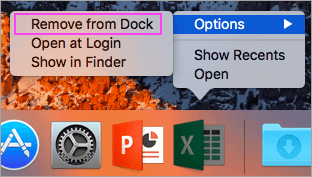
Part 3. What Is The Best Microsoft Office Removal Tool for Mac?
How to Uninstall Microsoft Office on Mac completely without deleting files again? The best Microsoft Office removal tool for Mac that you can use for uninstalling office on a mac completely with all the associated files is PowerMyMac from iMyMac.
You will also be able to preview all of those files first so that you can select which files should go and not. This amazing program will give you an easy way to uninstall the stubborn applications that you want to get rid of on your Mac, then you will be able to save more of your disk space and speed up your Mac as well.
Now let's look at the detailed steps on how to Uninstall Microsoft Office on Mac completely with PowerMyMac below:
- Download and install PowerMyMac on Mac then launch the software.
- On the main interface, select the App Uninstaller tool which can be seen on the left side.
- Click on the "SCAN" button to scan all your applications on Mac automatically.
- Locate and choose all the apps related to Office 2016.
- Hit on the "CLEAN" button, PowerMyMac will then uninstall Excel, Word, PowerPoint on Mac and will give you more storage space for your new applications that you are planning to download.
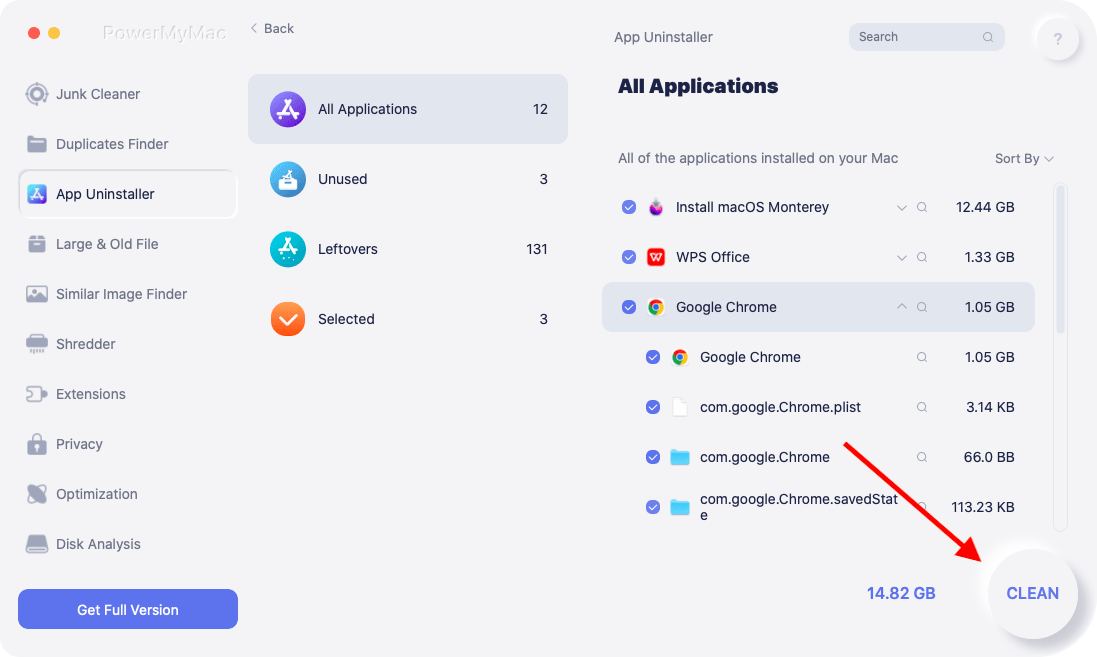
This is will also help you speed up your Mac. If you also want to uninstall office 2013 or any other apps on Mac, just let PowerMyMac do that for you.
Tip: Free to Try PowerMyMac
Now you know how to uninstall Microsoft Office on Mac with PowerMyMac. This program also has other things that can help you in optimizing your Mac PC like cleaning all unwanted files, finding duplicate files and folders, and more. You will also have the privilege to try the PowerMyMac with 500MB. Because of this, you will be able to clean up your Mac for free and will let you experience the powerful feature of the program. Just have the free trial here!




Manuel2020-11-17 10:25:15
Hola, no se si esta pagina este activa. Mi pregunta es: puedo emigrar mi licencia de office 2016 de una mac book a una mac mini? Esta licencia no tiene caducidad. De antemano gracias
iMyMac2020-11-18 10:39:16
Hola, Esta es la solución proporcionada por la comunidad de Microsoft, consulte: https://answers.microsoft.com/en-us/msoffice/forum/msoffice_install-mso_mac-mso_mac2016/transfer-office-for-mac-2016-license-to-new-mac/31b1e78a-979b-4014-8cb8-0c0f8aa7d071
Sikargal2019-02-06 13:02:24
Thank you, have successfully uninstalled Office 2016, but how can I determine if my Outlook mailbox is retained/retrieved after reinstallation?
iMyMac2019-02-06 13:55:06
You need to export the files by File > Export > Choose Everything firstly, then after uninstallation and reinstallation, go to copy everything back into Outlook by File > Import.